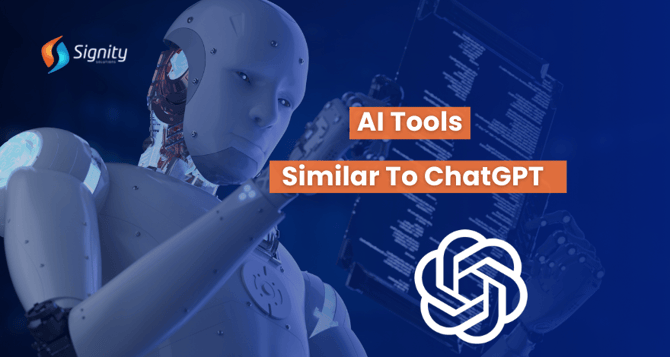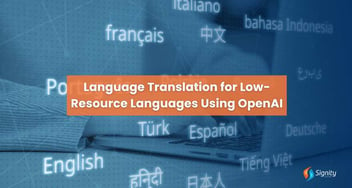10 AI Tools That Are Similar To ChatGPT
Explore a curated list of 10 cutting-edge AI tools that closely resemble ChatGPT. Discover innovative artificial intelligence solutions that share similarities with ChatGPT in terms of natural language processing, conversational abilities, and advanced language understanding.

In the realm of AI-powered natural language processing (NLP), ChatGPT has established itself as a frontrunner, offering advanced capabilities for understanding, generating, and interacting with human language. However, ChatGPT is not the only player in town. There exists a diverse landscape of AI tools that share similar goals and functionalities. In this article, we'll explore 10 AI tools that rival ChatGPT, providing a comparative analysis of their features, technical implementations, and potential use cases.
1. OpenAI GPT-3
Technical Implementation:
OpenAI's GPT-3 (Generative Pre-trained Transformer 3) is the architecture behind ChatGPT. It employs a transformer-based deep learning model trained on a vast corpus of text data to generate human-like responses to natural language prompts.
Features:
GPT-3 excels at various NLP tasks, including text generation, language translation, summarization, and sentiment analysis. Its massive parameter size (175 billion parameters) enables it to understand and generate contextually relevant responses across a wide range of topics.
Use Cases:
Chatbots, content generation, language translation, virtual assistants.
2. Google BERT
Technical Implementation:
Bidirectional Encoder Representations from Transformers (BERT) is a transformer-based model developed by Google. It employs bidirectional context to understand the meaning of words in a sentence based on their surrounding context.
Features:
BERT is particularly adept at understanding context and nuances in language, making it well-suited for tasks such as sentiment analysis, named entity recognition and question answering.
Use Cases:
Search engine optimization (SEO), chatbots, sentiment analysis, and text classification.
3. Facebook RoBERTa
Technical Implementation:
Robustly optimized BERT approach (RoBERTa) is a variant of BERT developed by Facebook AI. It builds upon BERT's architecture by incorporating additional pre-training data and training techniques for improved performance.
Features:
RoBERTa achieves state-of-the-art results on various NLP benchmarks, including sentiment analysis, natural language inference, and text classification.
Use Cases:
Text understanding, document classification, language modeling.
4. Microsoft Turing-NLG
Technical Implementation:
Turing-NLG is a large-scale language generation model developed by Microsoft Research. It utilizes a transformer architecture similar to GPT but incorporates additional training techniques to enhance its language generation capabilities.
Features:
Turing-NLG is optimized for natural language generation tasks such as text completion, summarization, and dialogue generation.
Use Cases:
Content generation, chatbots, virtual assistants, dialogue systems.
5. Hugging Face Transformers
Technical Implementation:
Hugging Face Transformers is an open-source library that provides pre-trained transformer models for various NLP tasks, including text generation, translation, and classification.
Features:
The library offers a wide range of pre-trained models, including GPT, BERT, RoBERTa, and more, making it versatile for different NLP applications.
Use Cases:
Text generation, language understanding, machine translation.
6. AllenNLP
Technical Implementation:
AllenNLP is an open-source NLP library developed by the Allen Institute for AI. It provides pre-built models and tools for various NLP tasks, including text classification, semantic parsing, and question-answering.
Features:
AllenNLP offers a modular architecture that allows users to customize and fine-tune models for specific tasks and datasets.
Use Cases:
Text classification, named entity recognition, semantic role labeling.
7. TensorFlow Text
Technical Implementation:
TensorFlow Text is a library built on top of TensorFlow for processing and modeling text data. It provides modules for tokenization, embedding, and sequence modeling, making it suitable for various NLP tasks.
Features:
TensorFlow Text offers pre-trained models for tasks such as word embedding, text classification, and sequence-to-sequence modeling.
Use Cases:
Text classification, language modeling, and machine translation.
8. PyTorch-NLP
Technical Implementation:
PyTorch-NLP is a library built on top of PyTorch for natural language processing tasks. It provides modules for tokenization, embedding, and sequence modeling, along with pre-trained models for various NLP tasks.
Features:
PyTorch-NLP offers a user-friendly interface and seamless integration with PyTorch, making it accessible for both researchers and practitioners.
Use Cases:
Text classification, sentiment analysis, language modeling.
9. SpaCy
Technical Implementation:
SpaCy is an open-source NLP library written in Python. It provides modules for tokenization, part-of-speech tagging, named entity recognition, and dependency parsing, among others.
Features:
SpaCy is known for its speed and efficiency, making it suitable for processing large volumes of text data in real time.
Use Cases:
Named entity recognition, part-of-speech tagging, dependency parsing.
10. FastText
Technical Implementation:
FastText is a library developed by Facebook AI for efficient text classification and word representation learning. It utilizes a shallow neural network architecture for training word embeddings and performing text classification tasks.
Features:
FastText is optimized for speed and scalability, making it well-suited for processing large datasets and training models on low-resource hardware.
Use Cases:
Text classification, language modeling, word embedding.
Conclusion
While ChatGPT has garnered widespread acclaim for its advanced natural language processing capabilities, it's important to recognize that it's just one among many AI tools in the NLP landscape.
Each of the tools mentioned above offers unique features, technical implementations, and potential use cases, catering to diverse needs and preferences. By exploring and experimenting with these tools, developers, researchers, and practitioners can unlock new opportunities for innovation and advancement in the field of natural language processing.


%201-1.webp)


.png?width=344&height=101&name=Mask%20group%20(5).png)



















